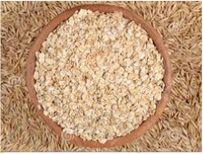Oat flour may be a bit more difficult to find if you don't mill your own flour. If you do have access to a mill buy oat groats they look like wheat berries and mill very nicely. Oat flour and wheat flour can be used for breads, cookies, cakes and many other baked goods. There are some important differences that you should be aware of when converting wheat flour recipes to oat flour ones.
Many people are attracted to oat flour for their baking because it's gluten-free, unlike wheat flour. Some people avoid gluten because of medical or dietary concerns. Gluten is a protein that makes dough elastic and baked goods chewy. Without gluten, oat flour can leave your baked goods heavy or the item may fall apart. Some cooks remedy this by adding more liquid or rising ingredients to their recipes. I find it's best to use oat flour in baked products that will benefit from the flours properties.
Since it has no gluten it's not the best choice for bread unless you mix it with a gluten flour like hard red or hard white flour in ratio of 1/3 oat flour to 2/3 hard red or white. If does make a great shortbread cookie, pie crust, or any baked item that does not need to raise and you want a very tender product. When making recipes that require baking powder, add 2 1/2 teaspoons baking powder per cup of oat flour. If you are using buttermilk in your recipe, add 1/2 teaspoon baking soda for each cup of buttermilk or any acid. This will neutralize the acid in the recipe and allow the baking powder to work more effectively. Adjusting the leavening agents will give your baked goods a bit more lift.
Oat flour has a lovely slightly sweet taste compared to a soft white wheat flour (pastry flour). Oat flour also tends to make baked goods more moist compared to wheat flour. Which again makes it a good choice for cookies and quick breads. In your cookie and quick bread recipes, replace up to 1/4 cup of the wheat flour with oat flour with usually no adjustments to the recipe.
Have fun experiment with different grains
Happy Baking
Tamara
Many people are attracted to oat flour for their baking because it's gluten-free, unlike wheat flour. Some people avoid gluten because of medical or dietary concerns. Gluten is a protein that makes dough elastic and baked goods chewy. Without gluten, oat flour can leave your baked goods heavy or the item may fall apart. Some cooks remedy this by adding more liquid or rising ingredients to their recipes. I find it's best to use oat flour in baked products that will benefit from the flours properties.
Since it has no gluten it's not the best choice for bread unless you mix it with a gluten flour like hard red or hard white flour in ratio of 1/3 oat flour to 2/3 hard red or white. If does make a great shortbread cookie, pie crust, or any baked item that does not need to raise and you want a very tender product. When making recipes that require baking powder, add 2 1/2 teaspoons baking powder per cup of oat flour. If you are using buttermilk in your recipe, add 1/2 teaspoon baking soda for each cup of buttermilk or any acid. This will neutralize the acid in the recipe and allow the baking powder to work more effectively. Adjusting the leavening agents will give your baked goods a bit more lift.
Oat flour has a lovely slightly sweet taste compared to a soft white wheat flour (pastry flour). Oat flour also tends to make baked goods more moist compared to wheat flour. Which again makes it a good choice for cookies and quick breads. In your cookie and quick bread recipes, replace up to 1/4 cup of the wheat flour with oat flour with usually no adjustments to the recipe.
Have fun experiment with different grains
Happy Baking
Tamara

 RSS Feed
RSS Feed
